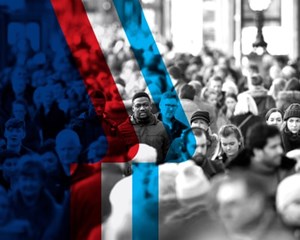Four years of Trump have accelerated the learning. The COVID-19 pandemic—which has killed people of color at higher rates than their white counterparts—has exposed the health disparities that divide this country. His campaign for "law and order" has only inflamed tensions and further highlighted the mistreatment that many Black Americans are likely to face at the hands of law enforcement. He attempted to schedule a rally on Juneteenth in Tulsa, Okla., the site of a 1921 massacre of Black people, inadvertently bringing attention to both the history of violence against Black Americans and the Juneteenth holiday, which celebrates the freeing of the enslaved. And that was just this year.
特朗普任期的四年加速了這方面的學習。新冠病毒下有色人種的死亡率高于白人,這暴露了美國存在的健康方面的差距。他倡導的“法律和秩序”運動只會給緊張局勢帶來負面影響,同時進一步突顯出許多美國黑人可能在執法人員手中遭受的虐待。他想要安排6月14日在曾于1921年發生過黑人大屠殺的俄克拉荷馬州塔爾薩舉行集會,這無意中引起了人們對針對美國黑人的暴力歷史和六月節(慶祝奴隸的解放)的關注。而這僅僅是今年的情況。
Some white Americans have reacted with outrage to this newfound understanding, joining Black Lives Matter rallies and reckoning with race in the workplace, at school and with friends. The marches this summer that captured the nation's attention, occurring in small towns and metropolises alike, are thought to be the largest mass demonstration in American history, collectively drawing nearly 9% of the country to the streets, according to datascience firm Civis Analytics.
一些美國白人對這一新發現表示憤怒,紛紛參加“黑人的命也是命”集會并在工作場所、學校和朋友之間都要顧及種族問題。數據科學公司Civis Analytics的數據顯示,今年夏天在小城鎮和大城市發生的游行吸引了全國的關注,被認為是美國歷史上規模最大的大規模示威活動,全國有近9%的人走上了街頭。

And yet nothing really changed. Gridlock in Washington stymied even modest reform efforts. Trump doubled down, using the unrest to stoke his base's fears of social unrest and crime with a seemingly endless stream of shock-and-awe television ads and dramatic rhetoric in his speeches. By the end of the summer, the marches still continued, but their strength—and, most important, their resonance with the larger American public—had started to fade. Why that happened and what can be done about it will be the work of the months to come.
然而,這并沒有真正改變什么。華盛頓的僵局阻礙了一些甚至溫和的改革努力。特朗普加大了打擊力度,沒完沒了地播放令人震驚的電視廣告,在演講中使用夸張的修辭,利用社會動蕩加劇選民對社會動蕩和犯罪的恐懼。在這個夏季結束之前,行軍仍在繼續,但他們的力量——最重要的是,他們與廣大美國公眾的共鳴——已經開始消退。為什么會發生這種情況以及對此我們能做些什么將是未來幾個月的工作。
When it came time to vote, tens of millions of Americans evidently shrugged off the racism. Many say they don't like Trump's handling of race but prefer his approach to the economy. That makes sense: sacrificing the welfare of a minority group for economic prosperity may not be uniquely American, but it is a part of the American DNA. For some others, Trump's stoking of racial hostilities has been more a feature of his presidency than a bug. At Trump's rallies, adoring crowds repeated and amplified the President, whether it was his reference to COVID-19 as "Kung flu" or adopting a chant of "Send her back" in reference to Ilhan Omar, a member of Congress born in Somalia.
在投票的時候,數千萬美國人顯然對種族歧視不屑一顧。許多人表示,他們不喜歡特朗普處理種族問題的方式,但更喜歡他處理經濟問題的方式。這是有道理的:犧牲少數群體的福利以換取經濟繁榮可能不是美國獨有的做法,但這是美國基因的一部分。對一些人來說,特朗普煽動種族敵意的做法更多的是他擔任總統期間的一個特點,而不是一個缺陷。在特朗普的集會上,無論是他把新冠肺炎稱為“Kung flu”,還是對出生在索馬里的國會議員伊爾漢·奧馬爾高喊“把她送回去”,崇拜他的人群不斷重復并將總統放大。
譯文由可可原創,僅供學習交流使用,未經許可請勿轉載。











